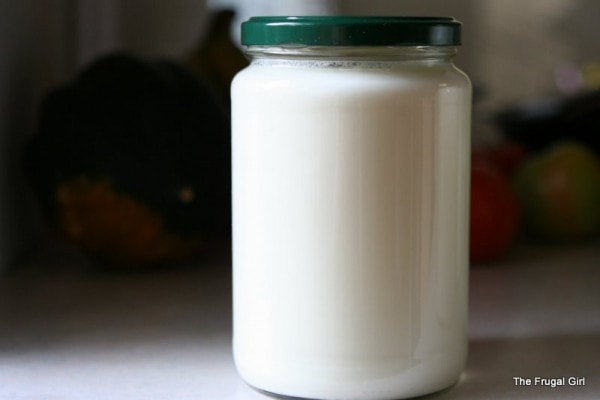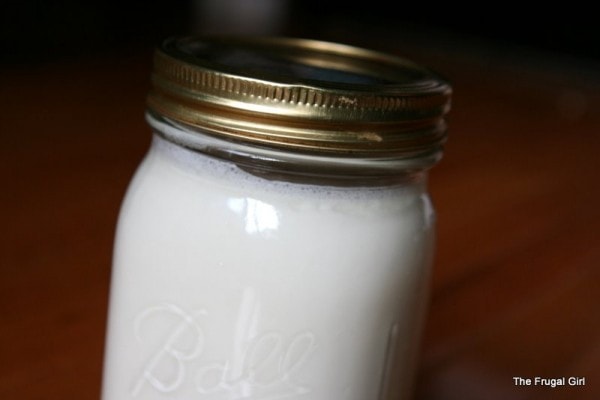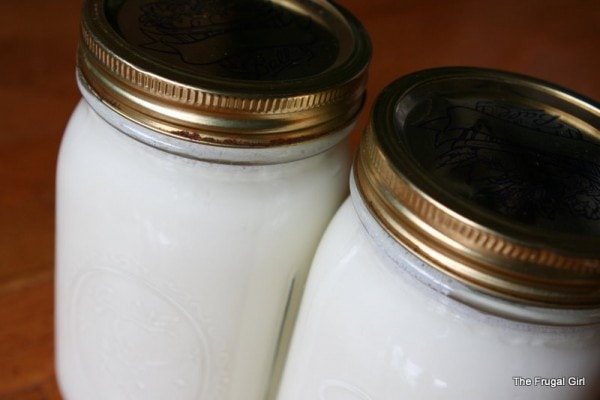After I posted my homemade yogurt recipe, I got enough questions to warrant a Q&A post devoted entirely to yogurt.
Several of you wondered if you HAVE to use Mason jars to make yogurt. The answer is a resounding “no!”. Any glass jar with a lid that seals can be used.
On Saturday, in fact, I put some of my yogurt in a pickle jar.
I like this jar because it has a nice wide opening. However, you should know that pickle jar lids need to be thoroughly washed and left in the sun for a while to get rid of the pickle smell. Of course, if you don’t mind pickle-infused yogurt, you don’t have to worry about that.
The pickle jar should smell fine after a thorough wash, although if yours still smells, you could always leave it out in the sun to take care of any remaining odor.
You can even use plastic containers, as long as they have a good seal on them. Without a water-tight seal, the warm water in the cooler will seep into your yogurt containers.
___________________________________
I also had a few readers that wanted to know if they could re-use the Mason jar lids. I’m happy to say that yes, you can do that. When you are doing honest-to-goodness canning, you need to use new lids each time so that a proper seal will form. When you make yogurt, though, you aren’t trying to get a shelf-stable seal, so an old lid works just fine.
As you can see, my lids and bands are banged up…
and the outsides are even a bit rusty.
But my yogurt turns out fine and dandy each time, despite the decrepit appearance of my lids.
(I hope it goes without saying that if a part of the lid that touches the yogurt is rusted, you should throw it out and use a new one. Outside rust is fine, inside rust is not).
_____________________
I am fascinated by making yogurt. How much time does it take? How much counter space do you need (an odd question, true, but my counter space is at a premium)? Am I insane for considering this when I work fulltime, have a toddler and am 6 weeks away from giving birth? Thank you for your help.
Kristin
Yogurt is one of those things that takes a while from start to finish, but requires very little hands-on time (kind of like bread!). I’d say the whole process, including the three hours of incubation, takes me about 4 hours. Honestly, though, only about 15 minutes of that four hours requires me to actually do something.
I don’t need a lot of counter space to make yogurt. The milk heats on the stove, cools in the sink, and incubates in a cooler on my kitchen floor. I only use the counter when I’m filling my jars with the heated milk. So, I’d say you need enough counter space for four Mason jars, and most kitchens are sufficiently equipped to handle that.
Since you work full-time, it would be pretty difficult to make yogurt during the week. It might be a good weekend project, though, and since it requires so little in the way of hands-on time, you could make it while you tackle other projects.
I know I’ve said this before, but if any of you are about to make yogurt for the first time, do give this a couple of tries before you decide whether or not it’s worth it. I thought it was really time-consuming the first time I did it, but after I got the hang of it, it seemed so much easier. Making yogurt saves me at least $572/year, so I’m really glad that I didn’t give up after that first try.
_______________________________________
If you’ve got more questions about yogurt, ask away!
And in case you’re still not tired of reading about yogurt, here are a few more yogurt-related posts for your browsing pleasure.
Why I Make My Own Yogurt
Cost Comparison of Yoplait and Homemade Yogurt
How to Make Homemade Yogurt




Rhonda Magee
Thursday 11th of April 2024
I love this instruction and recipe for yogurt. I was regularly making mu own back in the 80’s and ready to jump back in.
Here a couple of things I remember: You can keep the yogurt warm enough in an insulated container without the water bath. I let it set overnight in an insulated container wrapped with an extra blanket. If you want to use lower fat milk, you I can add nonfat dry milk (powder ) to add milk solids which adds thickness. I think I was using 1/2 cup powder to each gallon of milk. Worth a try.
We are trying to replicate some of the sugar free yogurt my husband seems quite addicted to. Here’s my plan: To the completed yogurt, I will mix in Monkfruit granulated sweetener. I will add finely ground freeze dried fruit, such as berries and apples. Mixed in, this should add nice flavor.
I will let you know how it goes!
Jody
Thursday 21st of July 2022
I was wondering why you should throw out lids that are rusty on the inside. Tetanus? I don’t know much about rust, but I was thinking if the lid is clean it would be fine. Thanks!
Kristen
Friday 22nd of July 2022
I mean, if the lid is pretty rusty, then rust bits could fall into the yogurt.
Lids are pretty cheap, and by the time they get rusty, I usually feel like they've done their duty!
Amy
Sunday 12th of January 2020
I’m thinking about making yogurt in my instant pot. I am wondering if, after it is done, can I put the yogurt in mason jars and use the old lids to store in the fridge? I’m not actually cooking the yogurt in the jars, so I wonder if there is a difference?
Kristen
Sunday 12th of January 2020
That should work fine as long as you sterilize the lids (boiling them will work just fine.) I noticed if I don't sterilize the lids, the yogurt doesn't last nearly as long without developing mold.
Rhonda
Monday 23rd of December 2019
Why did the whey go to the top of the yogurt l made in jars l did put in a cooler for 12 hours and l used low fat milk
Kristen
Tuesday 24th of December 2019
Usually the whey will separate to the top after I open a jar of yogurt, but not before. I do use whole milk, but I'm not sure if that would make such a difference.
Did the whey separate even before you opened the jars?
Pat Smith
Thursday 22nd of March 2018
I buy Greek yogurt because they say it is fat free. So if I make yogurt with whole milk and strain the whey does it reduce the fat and calories?
I have spent almost the entire evenng reading and making notes from your posts. Thanks so very much for all your information.
Kristen
Friday 23rd of March 2018
Nope, straining it will just remove the whey, which is not the fatty part of yogurt.
To make fat-free yogurt, you'd have to start with fat-free milk.
So glad my post has been helpful to you!